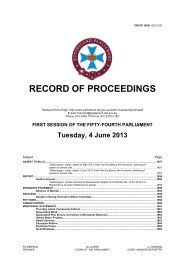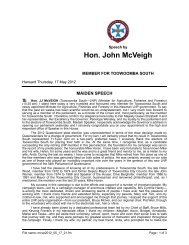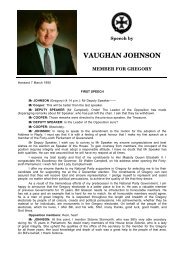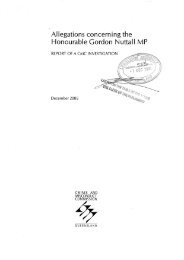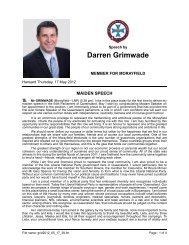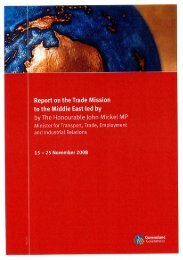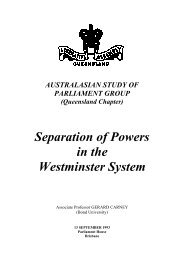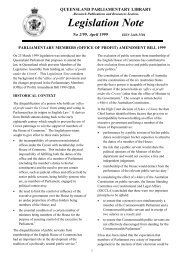weekly hansard - Queensland Parliament - Queensland Government
weekly hansard - Queensland Parliament - Queensland Government
weekly hansard - Queensland Parliament - Queensland Government
Create successful ePaper yourself
Turn your PDF publications into a flip-book with our unique Google optimized e-Paper software.
2622 Plumbing and Drainage and Other Legislation Amendment Bill 23 Aug 2005<br />
The primary purpose of this bill is to allow the use of grey water for watering gardens in sewered<br />
areas. The amendments to the Plumbing and Draining Act 2002 will, for the very first time, allow local<br />
governments to approve home owners using grey water to water gardens in areas served by a sewer<br />
system.<br />
As has been mentioned by many members of the House, some risks in the use of grey water<br />
have been identified, and managing those risks has been taken into account in this legislation. To<br />
manage any risks to public health grey water systems will have to use subsurface irrigation with pipes<br />
installed at least 100 millimetres below the surface. This avoids human contact with waste from<br />
laundries and showers which can carry traces of human waste. To manage any potential impact<br />
on amenity, no storage of grey water will be allowed. I understand that odour can be a problem if grey<br />
water is allowed to pool.<br />
To manage environmental risks, councils will have to approve all systems and assess whether<br />
land is suitable for grey water irrigation. Systems can only be approved for domestic homes where grey<br />
water generated is less than 3,000 litres per day and where there is sufficient land to distribute the<br />
water. It will also be possible for individual councils to decide whether they wish to receive applications<br />
for grey water systems. It is possible that some councils will decide to focus their resources on other<br />
water conservation and reuse initiatives such as water recycling.<br />
The Gold Coast City Council has done a lot to encourage residents of the Gold Coast to recycle<br />
water and to cut down on their use of water. I attended the Gold Coast City Council’s launch of its latest<br />
water futures campaign, which features a young girl. The campaign is called ‘When Kate is an adult will<br />
we have enough water?’ It is ironic that the day that I went to the breakfast launch was the first day of<br />
the rain that we had. I hope that it was a good sign for the Gold Coast. We did get a lot of rain out of that<br />
downpour over a week or so.<br />
We must not be complacent. We must continue to adhere to the restrictions that the council has<br />
enforced. I understand that this legislation will give local councils the power to enforce grey water use.<br />
There are a number of areas that local government will be responsible for in terms of the usage of grey<br />
water. This legislation goes into greater detail on those.<br />
I wanted to comment on what the Gold Coast City Council has done in the past. The previous<br />
council and the previous mayor did push their concern about water issues. I understand that the Gold<br />
Coast City Council has had great communications with the minister’s office and her department. I would<br />
assume that they have been quite supportive of this legislation. I hope that the council will take on board<br />
all the recommendations in this legislation and that residents on the Gold Coast look forward to using<br />
grey water as another alternative to saving water. I commend the bill to the House.<br />
Dr LESLEY CLARK (Barron River—ALP) (6.25 pm): It is with pleasure that I rise to speak in the<br />
debate on the Plumbing and Drainage and Other Legislation Amendment Bill 2005. It provides a<br />
legislative framework for local governments to allow the diversion of grey water from showers, baths and<br />
washing machines to underground water systems for irrigating gardens in urban sewered areas. The<br />
implementation of this long-awaited legislation has the capacity to significantly increase the efficiency of<br />
our use of water. It is only one of a range of demand measurement measures that need to be<br />
implemented if we are to use our water resources responsibly and sustainably.<br />
As the member for Cook indicated earlier in this debate, I have taken a particular interest in<br />
achieving this goal for the Cairns region in the face of a mayor whose only solution to achieving a<br />
reliable water supply for Cairns is to build another dam. In 2003 I, with the support of the relevant<br />
ministers at the time, initiated a series of water forums in Cairns that were targeted at council, at the<br />
community and at industry. One of the important recommendations to come out of those water forums<br />
was that Cairns needed to have a least-cost water planning study which focused on the situation in<br />
Cairns and how we could move forward in a cost-effective manner. It has been a long time coming, but<br />
the Cairns least-cost planning study was released in June of this year. I would like to spend time in my<br />
contribution to this debate making reference to this, because it is such an important document for Cairns<br />
and very much relates to our sustainable use of water which is a goal of the legislation we are debating<br />
here tonight.<br />
The study, carried out by MWH Australia Ltd, was a joint initiative of the EPA, Cairns Water and<br />
the Department of Natural Resources and Mines. I am very pleased to say that the government<br />
contributed financially to this report, indicating our commitment to this area. The study examined the<br />
options available on both the supply and the demand side with particular emphasis on the economic<br />
costs and benefits related to demand management options. Overall, the study aimed to define the leastcost<br />
program of supply augmentations and demand management initiatives for the Cairns water supply<br />
to 2044. I think it is really important to emphasise that this study takes us to 2044. It is quite clear that<br />
there is no need for a dam in that time frame. I will come back to the question of a dam later in my<br />
contribution.<br />
A separate study was undertaken during the course of this least-cost planning investigation to<br />
review and refine business-as-usual options for system augmentation. I would like to make clear the<br />
objectives of a least-cost plan. It is important that people do understand that its objectives are to develop



